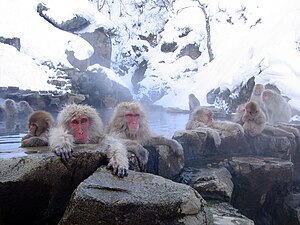 |
| Nihon Monkeys enjoy Onsen |
Onsen means hot spring. It is best known for bathing or soaking in mineral hot water, and it's another whole culture. This is undoubtedly a favorite trip destination for Japanese, and that includes all sorts of amusements that come along with it.
If the water is not either a hot spring or heated spring water, it can't be called Onsen. Onsen refers to the type of water they use, it doesn't mean the service or the type of facility. For a long time
Onsen were found mostly in mountainous rural areas. Some of truly adventurous Onsen hunters even now may be able to find a free hot spring in the wild where monkeys and other animals such as those pictured here may accompany you. Well, it's very unlikely but not impossible.
Onsen Trips
A common Onsen visit involves taking a short car or train trip, then checking in at a Ryokan (traditional Japanese inn) or a hotel overnight. The Onsen bath is usually offered by the accommodation. They may also have a public Onsen bath house, all depending on the area. This is a typical plan for group trips with family, friends, or co-workers.
Onsen destinations usually have the area developed along the Onsen and the accommodation. There might be some main strip type of street having souvenir shops, attractions and shops. Areas like Hakone, Ikaho, Beppu, Arima, Atami, etc. have a long history of being Onsen town communities. It's all planned out: visitors stay at a Ryokan or hotel, go out to browse in stores or visit nearby attractions during the daytime, and come back for dinner and to take a bath. Afterward, the adventurous adults go out again for drinking and karaoke. Hotels provide lots of amenities and attractions as well, inside of the building.
There are many Onsen in Japan, and each one has its own specialty. People who go to Onsen regularly also have their own special favorites.
Some people focus on the type of hot spring. I see so many different websites and blogs that concentrate on reporting the mineral content and reviewing the water. They don't care about the size or any other attractions. They likely rate highly the places that offer a public bath with minimal amusement for minimal fees.
Then there are people who care mainly about the type of bath. They prefer big, cozy ones that have a great landscape outside, offer different kinds of tubs, indoor and outdoor, and may even have a water park-type of facility for guests to enjoy.
Some people care about nearby attractions and amenities, and want everything in the hotel. Other people don't care about the accommodation and just visit the public bath houses. That's the main attraction for them.
A more traditional purpose of an Onsen visit is for medical treatment. In the early Meiji period (1868~1912) governmental records show permission granted to officials for an Onsen leave. An Onsen visit could be recommended along with the diagnosis. Actually, in the time before Meiji, an Onsen visit was considered medical treatment. Different Onsen contains unique types of minerals with special healing properties. I don't know the scientific facts behind this though.
There are a few Onsen facilities that exist for medical treatment purpose even now. This type of Onsen visit is called 湯治 (Toji: hot water + cure). People stay for weeks or months in a room with a shared kitchen.
Changing With The Times: Higaeri Onsen (Day Trip Onsen)
Current government authorities and companies are probably not as understanding compared to those of the Meiji era, and are not likely to grant long term work leave. So, a relatively recent way of visiting Onsen is 日帰り温泉 (higaeri onsen, meaning day trip Onsen).
Recent engineering and technology has enabled the tapping of hot springs from very deep underground. This means you don't have to go far away to a traditional Onsen area. Onsen can be found in the big cities like Tokyo, Osaka and Nagoya. It may not be possible to develop the whole town with accommodations, shops and attractions. Instead, such urban Onsen might feature a public bath house, or put everything into one building and offer a whole range of attractions. People can visit these places without staying overnight.
Traditionally, the Onsen bath facilities of Ryokan inns used to only be available for the inn's guests. Now, some inns open their baths to the general public, mostly during slow hours. Onsen destinations like Hakone, Atami and so on have started to have individual public bath houses without requiring any overnight accommodation. These establishments with their featured services are also called "day trip Onsen". Usually the day trip onsen facilities are convenient to a city area.
There are quite many Onsen in Japan. You can reserch this on the Internet. We look forward to introducing you to some of them in future posts, and passing along good resources you can use for planning your own visit to an Onsen.
Here is a video explaining what it's like to go to an Onsen.
No comments:
Post a Comment